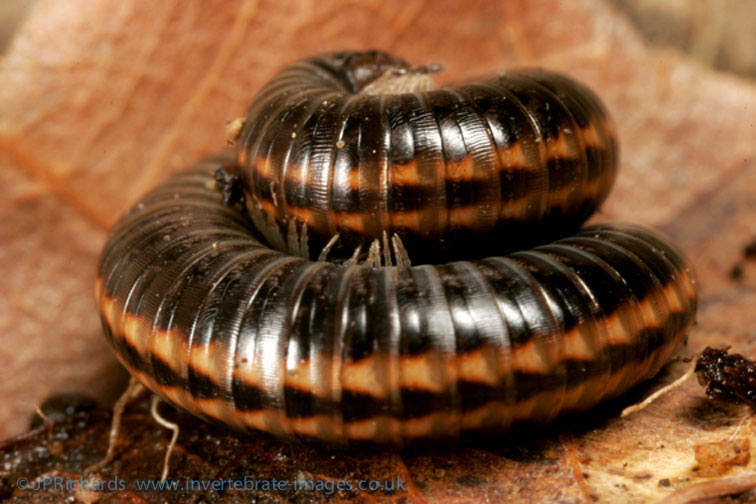Ommatoiulus sabulosus (Linnaeus, 1758)
Common name
Status:
GB IUCN status: Least Concern
ID Difficulty
Identification
A distinctive large species (to 30mm length) typically dark brown or black, with two conspicuous orange stripes running the entire length of the body. These stripes may sometimes be broken into a series of orange botches.
Confusion is most likely with immature Tachypodoiulus niger (which have a similar striped appearance) or Brachyiulus pusillus (which lacks the pointed projecting telson). As with T. niger, Ommatoiulus sabulosus bears traverse striae on the prozonites in addition to the usual longitudinal striae on the metazonites.
Distribution
Although generally widespread and common in Britain and Ireland, this species is surprisingly scarce in central southern and south eastern England.
This is one of the most widely distributed millipedes in Europe although it is absent from Iberia, Greece and many Mediterranean Islands (Kime, 1999).
Habitat
Adults wander widely in the summer and can occur in almost any type of habitat. However, analysis of the recording scheme data suggests this is largely a coastal species in Britain and Ireland showing a very strong association with sand dunes and a strong association with other maritime habitats and with heathland. A very strong association with sandy soils clearly links these habitats. Barlow (1957) and Biernaux (1969) also found that, in the Low Countries, the species preferred warm, well drained soils. However, the suggestion of a strong association with peaty soils in wetland and moorland habitats is surprising and not supported by work elsewhere in Europe.
Phenology
Adults can be found throughout the year but they are less frequently recorded in winter. At this time of year they appear to be less resistant to desiccation than in the summer and so are not actively wandering (Kime, 2004). In winter the adults can be found by searching through moist layers of soil and leaf litter. Fairhurst (1974) reported that males and females from a population living in sand dunes on Anglesey matured after two or three years respectively and one year earlier than the equivalent sex living in adjacent conifer woods.
This species account is based on Lee (2006).
Links
MilliBase - Global catalogue of Millipedes: https://millibase.org/aphia.php?p=taxdetails&id=151195







